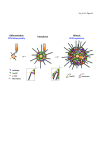Recent advances in pericentriolar material organization: ordered layers and scaffolding gels
- PMID: 29026530
- PMCID: PMC5583744
- DOI: 10.12688/f1000research.11652.1
Recent advances in pericentriolar material organization: ordered layers and scaffolding gels
Abstract
The centrosome is an unusual organelle that lacks a surrounding membrane, raising the question of what limits its size and shape. Moreover, while electron microscopy (EM) has provided a detailed view of centriole architecture, there has been limited understanding of how the second major component of centrosomes, the pericentriolar material (PCM), is organized. Here, we summarize exciting recent findings from super-resolution fluorescence imaging, structural biology, and biochemical reconstitution that together reveal the presence of ordered layers and complex gel-like scaffolds in the PCM. Moreover, we discuss how this is leading to a better understanding of the process of microtubule nucleation, how alterations in PCM size are regulated in cycling and differentiated cells, and why mutations in PCM components lead to specific human pathologies.
Keywords: centrosomes; mitosis; pericentriolar material (PCM).
Conflict of interest statement
Competing interests: The authors declare that they have no competing interests.No competing interests were disclosed.No competing interests were disclosed.No competing interests were disclosed.
Figures

References
Publication types
Grants and funding
LinkOut - more resources
Full Text Sources
Other Literature Sources

